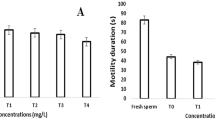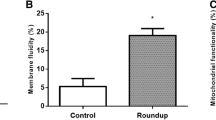Abstract
Exposure of sperm of killifish (Fundulus heteroclitus) from a relatively clean area in Long Island (LI) to 0.01 mg/L methylmercury (meHg) in 15%o sea water caused significant reduction of fertilization success. However, exposure of killifish sperm from polluted Piles Creek (PC) to either 0.01 or 0.05 mg/L meHg in 15%o sea water prior to insemination had no effect on fertilization success. Exposure of LI killifish sperm to 0.05 mg/L meHg caused significant reduction in motility. However, PC killifish sperm showed no significant difference in motility between 0 and 0.05 mg/L meHg exposure. Exposure for 5 min to 0.05 mg/L meHg caused significant reduction in motility. These data indicate that meHg is less toxic to PC killifish sperm than LI killifish sperm. Exposure of PC and LI killifish sperm to 0.05 mg/L meHg for 15 min had no effect on sperm morphology. PC killifish sperm also showed higher (20 min) motility in 15%o sea water than LI killifish sperm (10 min). Exposure of PC and LI killifish eggs up to 25 min to 0.05 mg/L meHg prior to fertilization had no effect on fertilization success.
Similar content being viewed by others
References
Abe T, Haga T, Kurokawa M (1975) Blockage of axoplasmic transport and depolymerization of assembled microtubules by methylmercury. Brain Res 86:504–508
Amstrong P, Child JS (1965) Stages in the normal development ofFundulus heteroclitus. Biol Bull Mar Biol Lab Woods Hole 128:143–168
Billard R (1978) Changes in structural and fertilization ability of marine and freshwater fish spermatozoa diluted in media of various salinities. Aquaculture 14:187–198
Billard R, Roubaud P (1985) The effect of metals and cyanide on fertilization in rainbow trout (Salmo gairdneri). Water Res 19:209–214
Brown BE (1976) Observations on the tolerance of the isopodAsellus meridianus Rac. to copper and lead. Water Res 10:555–559
Bryan WG, Hummerstone LG (1971) Adaptation of the polychaeteNeries diversicolor to estuarine sediments containing high concentrations of heavy metals. 1. General observations and adaptation to copper. J Mar Bio Assoc UK 51:845–863
Callahan P, Weis JS (1983) Methylmercury effects on regeneration and ecdysis in fiddler crabs (Uca pugilator, U. pregnax) after short term and chronic pre-exposure. Arch Environ Contam Toxicol 12:707–714
Duplinsky PD (1982) Sperm motility of northern pike and chain pickerel at various pH values. Trans Amer Fish Soc 11:768–771
Fraser J, Park T, Verspoor E (1978) Tolerance to lead in the freshwater isopodAsellus aquaticus. Water Res 12:637–641
Hall LW, Horseman LO, Zeger S (1984) Effects of organic and inorganic chemical contaminants on fertilization, hatching success, and prolarval survival of striped bass. Arch Environ Contam Toxicol 13:723–729
Imura N, Mirua K, Inokawa M, Nakada S (1980) Mechanism of methylmercury cytotoxicity: By biochemical and morphological experiments using cultured cells. Toxicology 17:241–254
Kobayashi N (1971) Fertilized sea urchin eggs as an indicatory material for marine pollution Bioassay; preliminary experiments. Publ Seto Mar Biol Lab 28(6):379–406
Koepp SJ, McCormick JM, Cheng SL (May 1980) Distribution, flux, and biological effects of heavy metal pollution in the Newark Bay Estuary. Paper presented at the Water Conference, Ramapo College, Mahwah, NJ
Levington JS (1980) Genetic divergence in estuaries. In: Kennedy V (ed) Estuarine perspectives. Academic Press, New York, pp 509–520
Luoma SN (1977) Detection of trace contaminant effects in aquatic ecosystems. J Fish Res Board Can 34:436–439
McIntyre JD (1973) Toxicity of methylmercury for steelhead trout sperm. Bull Environ Contam Toxicol 9:98–99
Miura K, Suzuki K, Imura N (1978) Effects of methylmercury on mitotic mouse glioma cells. Environ Res 17:453–471
Mohamed MK, Lu WI, Mottet NK, Burbacher TM (1986) Laser light-scattering study of the toxic effects of methylmercury on sperm motility. J Androl 7:11–15
Mohr LC, Chalanchuk SM (1985) The effect of pH on sperm motility of white sucker,Catostomus commersoni, in the experimental lakes area. Environ Biol Fish 14:309–314
Moraitou-Apostolopoulou M, Verriopoulos G, Rogdakis I (1982) Evaluation of the stress exerted by a polluted environment to a marine organism by comparative toxicity tests. Bull Environ Contam Toxicol 28:416–423
Mohri H (1963) Studies on the respiration of sea-urchin spermatozoa. J Exp Biol 40:573–586
Nelson L (1960) Cytochemical studies with the electron microscope: III. Sulfhydryl groups of rat spermatozoa. J Ultrastructure Res 4:182–190
Pagano G, Esposito A, Giordano GG (1982) Fertilization and larval development in sea urchins following exposure of gametes and embryos to cadmium. Arch Environ Contam Toxicol 11:47–55
Renna MS (1982) The effect of polluted water and methylmercury on fin regeneration and swimming stamina of killifish (Fundulus heteroclitus): A comparison between two populations. MS Thesis, Rutgers Univ, Newark, NJ
Rosenthal H, Alderdice DF (1976) Sublethal effects of environmental Stressors, natural and pollutional, on marine fish eggs and larvae. J Fish Res Board Can 33:2047–2065
Rothschild L, Cleland KW (1952) The physiology of sea-urchin spermatozoa. The nature and location of the endogenous substrate. J Exp Biol 29:66–71
Shaw TL, Brown VM (1971) Heavy metals and the fertilization of rainbow trout eggs. Nature 230:251
Stewart NH (1926) Development, growth, and food habits of the white sucker (Catostomus comersoni) Leseur. Bull US Bur Fish 42:147–184
Toppin S (1985) Factors and mechanisms affecting the toxicity of mercury to the killifish,Fundulus heteroclitus. PhD Thesis, Rutgers Univ, Newark, NJ. 134 pp
U.S. Environmental Protection Agency (1972) Quarterly Research Report, March, 1972. National Water Quality Lab, Duluth, Minnesota
Weis JS, Weis P (1977a) Effects of heavy metals on development of the killifish,Fundulus heteroclitus. J Fish Bioi 11:49–54
Weis JS, Weis P, Heber M, Vaidya S (1981) Methylmercury tolerance of killifish (Fundulus heteroclitus) embryos from a polluted vs non-polluted environment. Mar Biol 65:283–287
Weis JS, Weis P, Heber H (1982) Variation in response to methylmercury by killifish (Fundulus heteroclitus) embryos. In: Pearson JG, Foster RB, Bishop WE (eds). Aquatic Toxicology and Hazard Assessment: Fifth Conference ASTM STP 766 Hazard Assessment. Amer Soc for Testing and Materials, Philadelphia, pp 109–119
Weis JS, Weis P (1984) A rapid change in methylmercury tolerance in a population of killifish,Fundulus heteroclitus, from a golf course pond. Mar Environ Res 13:231–245
Weis JS, Renna M, Vaidya S, Weis P (1987) Mercury tolerance in killifish: A stage-specific phenomenon. In: Capuzzo JM, Kester DR (eds) Oceanic processes in marine pollution: Volume 1 Biological processes and wastes in the Ocean, Krieger Pub Co, Malabar Fl. pp 31–36
Weis P, Weis JS (1977b) Methylmercury teratogenesis in killifish,Fundulus heteroclitus. Teratology 16:317–326
— (1982) Toxicity of methylmercury, mercuric chloride, and lead in killifish (Fundulus heteroclitus) from Southampton, New York. Environ Res 28:364–374
Zar JH (1984) Biostatistical Analysis. 2nd ed, Prentice-Hall, Englewood Cliffs, New Jersey
Author information
Authors and Affiliations
Rights and permissions
About this article
Cite this article
Khan, A.T., Weis, J.S. Effects of methylmercury on sperm and egg viability of two populations of killifish (fundulus heteroclitus). Arch. Environ. Contam. Toxicol. 16, 499–505 (1987). https://doi.org/10.1007/BF01055273
Received:
Revised:
Issue Date:
DOI: https://doi.org/10.1007/BF01055273




